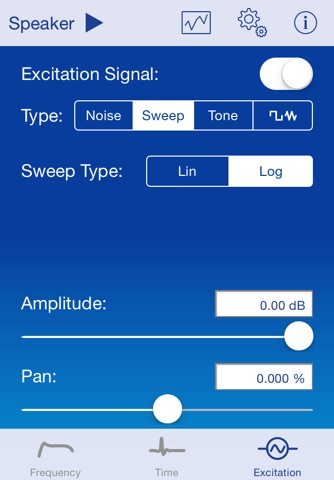
Note: IOScope is being succeeded by the new SignalScope X. IOScope will continue to receive maintenance updates and remain for sale on the App Store for a limited time. Beyond that time, you will be able to continue to use IOScope as long as you run it on a device with a compatible version of iOS. SignalScope X offers powerful new tools and features. You can download it and try it out for free for 7 days.
IOScope brings two-channel transfer function and impulse response analysis to iOS! See http://youtube.com/faberast for video demos.
With IOScope, measure loudspeaker impedance, frequency response, and sensitivity. Measure a room impulse response. Tune a large sound reinforcement system, time-align a set of surround sound speakers, or optimize your home stereo. Determine the actual cutoff frequencies of your latest speaker crossover circuit, or teach your students the fundamentals of Fourier analysis of dynamic systems.
Measure frequency response magnitude and phase, coherence, and group delay. Time domain functions enable you to measure impulse response and auto/cross-correlation. IOScope includes a built-in signal generator for producing suitable excitation signals to analyze your system or device under test (DUT). The reference signal can be taken from the internal signal generator or from an external source (when using an external reference, a stereo or multi-channel audio input device, connected to the dock connector, is required).
IOScope also turns your iOS device into a platform for data acquisition, storing acquired data in CSV or TXT files, MAT-files, or images for later retrieval from your device.
Different engineering units, including Volts, Amps, pascals, gs, and ips (inches per second) can be assigned to input channels of the dock connector audio input or the headset input. Sensitivity calibration can also be performed for any audio input device or input channel.
“Touch” your data with interactive, multi-touch enabled analyzer displays.
IMPORTANT NOTE: For best results, using a dock connector input device is recommended for the highest quality measurements. It is possible to use IOScope with the built-in microphone, but this is not generally recommended.
Visit http://blog.faberacoustical.com for important information about iOS device I/O.
Features:
- Analyze signals coming from the iOS device’s current audio input path.
- Measure device (DUT) characteristics by analyzing its input (X) and output (Y) signals.
- Measure frequency response magnitude and phase, coherence, and group delay.
- Measure impulse response (IR), squared IR, and cross-correlation.
- Frequency resolutions from 0.2 Hz to 10 Hz.
- Measurement durations from 0.1 to 5 seconds.
- Employ an external or internal reference (X) signal.
- Reference (X) signals include: Internal Excitation Signal, Built-in Microphone, Headset Input, Ch1, Ch2, Ch2-Ch1 (depending on which audio input device is currently selected by the OS).
- Measurement (Y) signals include: Built-in Microphone, Headset Input, Ch1, Ch2 (depending on which audio input device is currently selected by the OS).
- Use cursor peak track to easily measure time delay.
- Apply sample-accurate delay to the reference (X) signal for the highest quality measurements using an external reference (e.g. to compensate for acoustic delay in a sound reinforcement system).
- Audio input is generally sampled at 48 kHz, although some input devices limit that to 44.1 kHz.
- Assign engineering units to your input signals and calibrate external transducers for accurate measurements (this allows IOScope to measure impedance in ohms, or device sensitivities such as SPL/V or V/Pa).
- Save acquired time or frequency data to CSV, TXT or MAT-files.
- Retrieve your data files via iTunes File Sharing, or from your device through a web browser on your Mac or PC.
- Save high-resolution analyzer display images as PDF files, or to the iOS devices built-in photo album.



